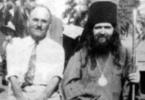Abbess Mary (Robinson) of the convent in Gethsemane passed away on this day in 1969.
The raspahor nun Valentina (Tsvetkov) played an essential role in the conversation of Stella Robinson and her companion Alexandra (Frances) Sprot. Sister Valentina (Mother Barbara in the small schema) was born in Moscow into the family of the director of the State Bank of Russia. The family was pious, and Valentina knew holy people in Russia, including St. Anatolii of Optina and Bishop Anastassy of Chudov Monastery in the Moscow Kremlin (the future ROCOR’s first hierarch). Clearly, the two British women became fascinated with that Gladsome Light of Russian Orthodoxy which Sister Valentia shared with them.
In 1929, Marion became an Anglican nun with the name Stella. Monasticism in the Anglican Church was more of a social rather than a contemplative nature. Therefore, the familiarity of Sister Valentia with Sts. Martha and Mary Convent in Moscow, which in its turn was inspired by contemporary Anglican missions, helped in the conversion of the two educated Scottish ladies.
Both Glaswegian ladies stopped in Jerusalem, at that time governed by the British Empire, en route to the British Raj (India). Archbishop Anastassy of Kishinev and Hotin was the Head of the Russian Ecclesiastical Mission in Jerusalem from 1925 to 1936. He had closely worked with the Anglicans in the Holy Land, and the conversion of the two Scottish ladies became an important event.
The church of St. Mary Magdalene in Gethsemane was built by the Russian Imperial Palestine Society in 1888. The newly tonsured sisters Mary and Martha were supposed to follow the path of Mary, inner spiritual work, in Gethsemane, and that of Martha in the newly founded school for the girls in Bethany.
After the end of the British mandate over Palestine decreed by the League of Nations, Abbess Mary stayed in Gethsemane and Bethany. Her presence there on the ground helped to protect properties during the events surrounding the “two-state solution” in 1948 and the six-day war of 1967 when the Russian Ecclesiastical Mission of the ROCOR came under Israeli control.
Relevant Link:
Archimandrite Roman (Krassovsky), “Bethany: Holy Work of the Russian Church Abroad”.
Source:
V.A. Kuznetsov, Russkoe pravoslavnoe zarubezhnoe monashestov v XX veke: Biograficheskii spravochnik [Russian Orthodox Monasticism Abroad in the 20th Century: A Biographical Reference] (Ekaterinburg, 2015).










